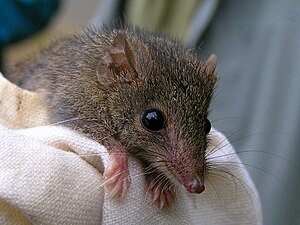Gray broad-footed pouch mouse
| Gray broad-footed pouch mouse | ||||||||||||
|---|---|---|---|---|---|---|---|---|---|---|---|---|

Gray broad-footed bag mouse ( Antechinus agilis ) |
||||||||||||
| Systematics | ||||||||||||
|
||||||||||||
| Scientific name | ||||||||||||
| Antechinus agilis | ||||||||||||
| Dickman , Parnaby , Crowther & King , 1998 |
The Agile Antechinus ( Antechinus agilis ) is a bag species from the genus of antechinus .
description
The gray broad-foot bag mouse has a head-trunk length of 6.2 to 12.8 cm and a 6 to 11.6 cm long tail. Males reach a weight of 20 to 40 g, females remain significantly lighter at 16 to 25 g. The tail is thin and, in most cases, as long as the head and trunk. The coat has a gray or gray-brown tint. The back side is a bit darker and the belly side and a conspicuous ring around the eyes a bit lighter. From the Stuart broad- foot sac mouse ( Antechinus stuartii ), which occurs further north , the gray broad -foot sac mouse differs in its small size, gray fur, larger upper incisors, a cusp on the side of premolars 1 to 3 facing the tongue and a larger eye relief.
Distribution and way of life
This pouch-mouse inhabits humid forests from the coast to heights of 2000 meters in southeastern Australia - in southeastern New South Wales and in Victoria . The diet consists mainly of invertebrates . It prefers to eat larger insects such as cockroaches , large beetles and spiders , and occasionally small skinks and berries. This species is known to go into a torpor when there is a lack of food .
As with all broad-foot pouch mice, all males of Antechinus agilis die synchronously after the mating season. The young are born after a gestation period of about 27 days.
threat
This species is widespread, although its habitat has been reduced as a result of deforestation, plantations, crops, land grabbing through controlled fires, and the introduction of cats and red foxes. Despite these aspects, there is nothing to indicate that this species is threatened. The IUCN lists them as safe (least concern) .
Taxonomy
As early as the 1980s it was found that the populations of Antechinus stuartii about south of the 35th parallel differ significantly from those in the north. But it was not until 1998 that this southern population was formally first described as a separate species, Antechinus agilis .
swell
- Groves, Colin (November 16, 2005). in Wilson, DE, and Reeder, DM (eds): Mammal Species of the World , 3rd edition, Johns Hopkins University Press, 29, ISBN 0-801-88221-4 .
- Dickman, CR (1995): "Agile Antechinus", in Strahan, Ronald: The Mammals of Australia , Angus & Robertson, pp. 98-99, ISBN 0-7301-0484-2
- Menkhorst, Peter (2001): A Field Guide to the Mammals of Australia . Oxford University Press, 56.
Individual evidence
- ^ A b Andrew Baker: Family Dasyuridae (Carnivorous Marsupials). Page 309 in Don E. Wilson , Russell A. Mittermeier : Handbook of the Mammals of the World - Volume 5. Monotremes and Marsupials. Lynx Editions, 2015, ISBN 978-84-96553-99-6
- ↑ Antechinus agilis in the endangered Red List species the IUCN 2016 Posted by: C. Dickman et al, 2015. Retrieved on July 21, 2020..
